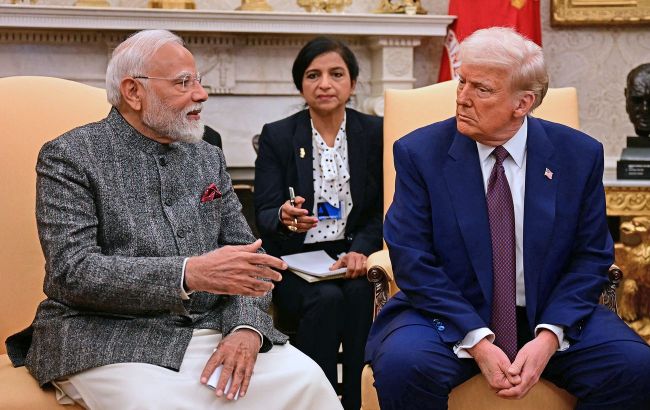Price of friendship with Putin: Can US force India to abandon Russian oil?
 Photo: Trump is conducting tough negotiations with the Indian government (Getty Images)
Photo: Trump is conducting tough negotiations with the Indian government (Getty Images)
Lately, the United States' attention has been focused on India. With the help of high tariffs, Donald Trump is putting Narendra Modi's government before a choice – either Russian oil or trade relations with Washington.
How dependent India is on supplies of oil from the aggressor country, whether it has alternative sources, and how the negotiations with the US might end – all this is covered in the RBC-Ukraine article.
Key questions:
-
How trade negotiations between the US and India are going
-
How much Russian oil New Delhi is buying
-
Can India give up Russian oil
-
Can Trump pressure India into backing down
Negotiations between the US and India over tariffs have been ongoing since early April, when US President Donald Trump declared a trade war on most countries worldwide. Speaking on April 2 at the White House, Trump held in his hands the well-known chart of tariffs that were proposed to be introduced against many countries. India rounded out the top five countries on that chart, with a proposed tariff of 26%. Later, Trump postponed the immediate imposition of tariffs and gave 90 days for negotiations – until the beginning of August.
After the Kremlin’s behavior did not meet the expectations of the US, the issue of Russian oil was added to the negotiation track between Washington and New Delhi. Initially, Trump gave Russia 50 days to reach a peace agreement, but later shortened this period to 10 days. He also threatened countries that purchase Russian oil with secondary sanctions – that is, the US will introduce increased tariffs on the goods of those countries.
Volumes of Russian oil deliveries
The largest buyers of oil from Russia are China, India, and Türkiye. According to data from the analytical center of the Kyiv School of Economics, in June, China was buying around 2 million barrels of Russian oil per day, India – 1.5 million barrels, and Türkiye – 0.9 million barrels.
Throughout the full-scale war, India remains the second-largest buyer of Russian oil in the world, after China. Its volume of purchases has increased 15-fold since February 2022. Before the full-scale war against Ukraine, India was buying very small amounts of oil from Russia (around 0.1 million barrels per day in January 2022).
Even China did not increase its purchases of Russian oil as much – its pre-war deliveries were 1.6–1.8 million barrels per day, and during the full-scale invasion, they increased to a maximum of 2.6 million barrels per day.

Photo: Indian refineries have drastically increased purchases of Russian oil since early 2022 (Getty Images)
The US decided not to burden the already complicated negotiations with China, but India "got caught in the crossfire." On July 30, Trump accused India of charging the US more tariffs than almost any other country and threatened tariffs of 20–25%.
Starting from August 1, the US officially imposed a 25% tariff on goods from India. This is quite a high rate – for example, goods from the United Kingdom are taxed at 10%, and from the EU – 15%.
The strict policy of the White House alarmed Indian companies. They began to limit purchases of Russian oil, even bought a bit of American crude, but are not planning to abandon supplies from the Russian Federation yet fully. On August 2, India’s Ministry of Foreign Affairs stated that "bilateral relations with Russia have their own weight and cannot be evaluated through the prism of third countries."
This only intensified Trump's aggressive position, who on August 4 wrote on the social network Truth Social that India does not care how many people in Ukraine are dying from the Russian war machine. The next day, the US president announced that he would significantly increase tariffs on Indian goods within 24 hours.
According to Bloomberg, the Indian side did not expect such decisions from Trump and is seeking ways to mitigate economic losses. The Narendra Modi government is planning to accelerate a financial support program for its exporters.
Alternative at hand
India has significantly increased seaborne purchases of Russian oil due to deep discounts offered by Moscow, aimed at partially restoring lost export volumes to Europe.
"Why are they buying? Because Russia offers oil at huge discounts, which naturally creates competitive advantages," energy expert Hennadii Riabtsev told RBC‑Ukraine.
He added that it would not be difficult for India to revert the oil trade with Russia back to 2021 levels, when Russian oil made up only a few percent of its total imports. Today the global oil market is oversupplied—supply exceeds demand and producing nations are actively competing for buyers—so Delhi will face no problem replacing Russian imports.
Moreover, India is geographically adjacent to one of the world’s largest oil and gas regions—the Persian Gulf, which includes Saudi Arabia, the UAE, Iraq, and others.
"It has free access to markets, no maritime restrictions, absolutely no problem buying oil," said analyst Oleksandr Sirenko of consulting firm Naftorynok.

Photo: Saudi Arabia and other Persian Gulf countries are alternative sources of oil supplies to India (Getty Images)
Experts believe Indian refineries can technologically switch from Russian to other crude grades.
"The equipment parameters change. Another crude type yields a different range of light and heavy products. It’s not a problematic issue. Of course, there are better or worse crude types for refining, but a plant can be adjusted to this or that grade," added Sirenko.
To stop or significantly reduce purchases of Russian oil, Indian oil companies won’t need much time because they mostly don’t sign long‑term contracts with Russian suppliers. Such trade is mainly spot deals—agreed upon today, with the vessel arriving next month.
"They will stop concluding contracts and that’s it—the next month or the month after tankers with Russian oil will have to find another buyer. It’s a matter of a few months," says Hennadii Riabtsev.
Transfers under foreign flags
If India begins reducing its imports from Russia, Moscow will seek new buyers, but no one is likely to take such large volumes. China will continue diversification and not significantly raise its share of Russian oil.
"No one wants dependence on a single supplier, especially a risky one like Russia," Riabtsev believes.
Thus, the aggressor country will seek smaller markets and also attempt to use oil supply via third countries. As Bloomberg reported last November, about 60 km off Malaysia’s coast in the South China Sea lies the world’s largest shadow tanker fleet gathering point, where oil is transferred from ship to ship.
Thus, sanctioned Russian oil from one tanker can be offloaded to another vessel and then declared as being of a different origin. The publication released dozens of images of two tankers berthed alongside each other. This "laundering" method was used for Iranian crude moving from Malaysian waters to China.

Photo: Transferring oil from one tanker to another on the high seas is a powerful way to circumvent sanctions (Getty Images)
"Ship to ship" (from English: from vessel to vessel – ed.) is an unmonitored oil and petroleum products supply route, when vessels turn off navigation and conduct transfers at sea. This is the 'Achilles' heel' of sanctions. Investigations show that this is happening in Europe and globally," says Oleksandr Sirenko.
But, there is opposition to everything. The US has capabilities to track oil transfer operations in open waters and the movement of funds through bank accounts.
"If America seriously took this on, using all the technologies and financial instruments (to monitor interbank transactions), something could be achieved. The US has the full toolkit for this," added the analyst from the company Naftorynok.
To stop maritime deliveries of Russian oil, the US is already preparing a sanctions package against the shadow fleet. Sources of the Financial Times report that Washington is preparing such a step in case Vladimir Putin refuses to agree to a truce with Ukraine.
Importance of the American market
Washington actively uses the instrument of tariffs because it understands the significance of its market for other countries of the world. The USA is the richest buyer; everyone wants to sell something to this country, and tariffs increase the cost of goods and reduce their competitive position.
The USA supplies fewer goods and services to the outside world than it receives from it, which creates a trade deficit that worries the Trump administration. The economies of many countries are highly dependent on the sale of goods to the American market, making them vulnerable in trade negotiations with Washington.
India is no exception. In 2024, the USA sold goods worth $41.5 billion to India and purchased goods worth $87.3 billion, according to statistics from the Office of the United States Trade Representative. Thus, the US trade deficit with India last year amounted to $45.8 billiont.
The situation in India's trade with Russia is radically opposite. Data from the Indian embassy in Moscow indicate that in the 2024–2025 financial year (from April 1, 2024, to March 31, 2025), India exported goods to Russia worth $4.9 billion and imported goods worth $63.8 billion. The main items of Indian imports were oil and petroleum products. That is, India’s trade deficit with Russia is about $59 billion.

Photo: The trade balance between India and Russia is in surplus for Moscow (Getty Images)
"Trump is correctly saying that India mainly buys oil from the Russians and sells them almost nothing. He sees that American money is going to finance Russian oil," said the Deputy Director of the Association of Energy and Natural Resources, Andriy Zakrevskyi.
In the case of India, it is essential to mention that this country is one of the world’s largest providers of outsourcing services for Western companies. Thousands of Indian residents, even without leaving their homes, work for American and European companies, preparing various reports, performing calculations, and so on.
Zakrevskyi is convinced that India cannot afford to lose the American market for such services. It is precisely this sensitive sphere that Washington will pressure.
"Trump will exert very strong pressure, and he will do it through the services sector. India provides outsourcing services to companies worldwide, generating approximately $178 billion annually, with the US accounting for the largest share of this amount. I think Trump will push Modi to the limit," the expert said.
India is the largest developing economy in the world. Its government faces a major challenge—to ensure a proper standard of living for 1.5 billion people. It requires a significant amount of energy resources, but aside from Russian ones, there are other large sources of raw materials nearby. With their help, India can ensure the growth of its economy, while not financing the largest war in Europe in recent decades.

